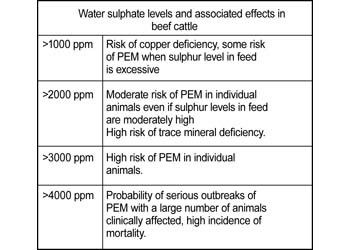Naomi Paley
Regional Livestock Specialist
Yorkton Regional Office
Saskatchewan Ministry of Agriculture
Sulphate can be found in almost all natural water and is probably the most common contaminant of water sources for livestock in Saskatchewan. High levels of sulphate in drinking water have considerable impact on both health and performance of animals.
Water sources containing excess levels of sulphate are not very palatable, and, when given a choice, animals will discriminate against them. Some animals may refuse to drink high sulphate water, which may lead to dehydration. However, in desperate situations (e.g. drought, hot weather, and prolonged water deprivation) some animals will consume water even with extremely high levels of sulphate, resulting in toxicity.
The most dramatic outcome of exposure to high sulphate water in cattle is the development of necrotic lesions in the brain, a condition commonly described as Polioencephalomalacia (PEM). The pathogenesis of sulphate toxicity shows that ruminants have some unique features of sulphur metabolism resulting in lesions of the brain. High concentration of sulphides in the rumen fluid has been observed in animals that developed PEM.
Given the profound metabolic effects of excessive sulphur intake on metabolism or availability of essential nutrients, high levels of dietary sulphate adversely affect basic physiological processes and influence growth and performance. Cattle exposed to excess dietary sulphur perform poorly and production losses can be substantial as shown in a study on steers where the average daily gain declined from 1.39 to 1.01 lb/day as the sulphates in drinking water increased from 400 to 3100 ppm.
The problems resulting from sulphate interaction with essential nutrients, such as copper, may indirectly affect performance parameters known to be attributed to copper deficiency, such as reduced growth rate, weight loss, reduced fertility and delayed puberty, low conception and ovulation rates in cows, as well as reduced semen quality in bulls. Retained placenta may also be a sign of secondary copper deficiency. Lower body weights of cows and calves and increased mortality of calves during the postnatal period was observed when animals were drinking water containing 1500 ppm of sulphate. Calves born from copper deficient cows, and young calves exposed to excess sulphur, may display in-coordination and inability to suckle. Reduced immune response can also be associated with sulphate and/or molybdenum induced copper deficiency.
In ruminants high, or moderately high levels of sulphates in drinking water are detrimental to health, and relatively low to moderate levels affect performance of animals. In order to assess the potential hazard, the total intake of dietary sulphur must be taken into consideration. Sulphate in the water, even at moderate levels, may increase the total dietary sulphur to a toxic level.
Sulphate levels in dugouts can increase throughout the pasture season as evaporation lowers water levels and concentrates minerals. It is important to monitor cattle using dugouts with elevated sulphate levels. Testing dugouts in dry years is an important routine to ensure the safety and well-being of your livestock.
For more information on water testing or sulphate’s in drinking water contact your Regional Livestock Specialist or the Ag Knowledge Centre at 1-866-457-2377.

